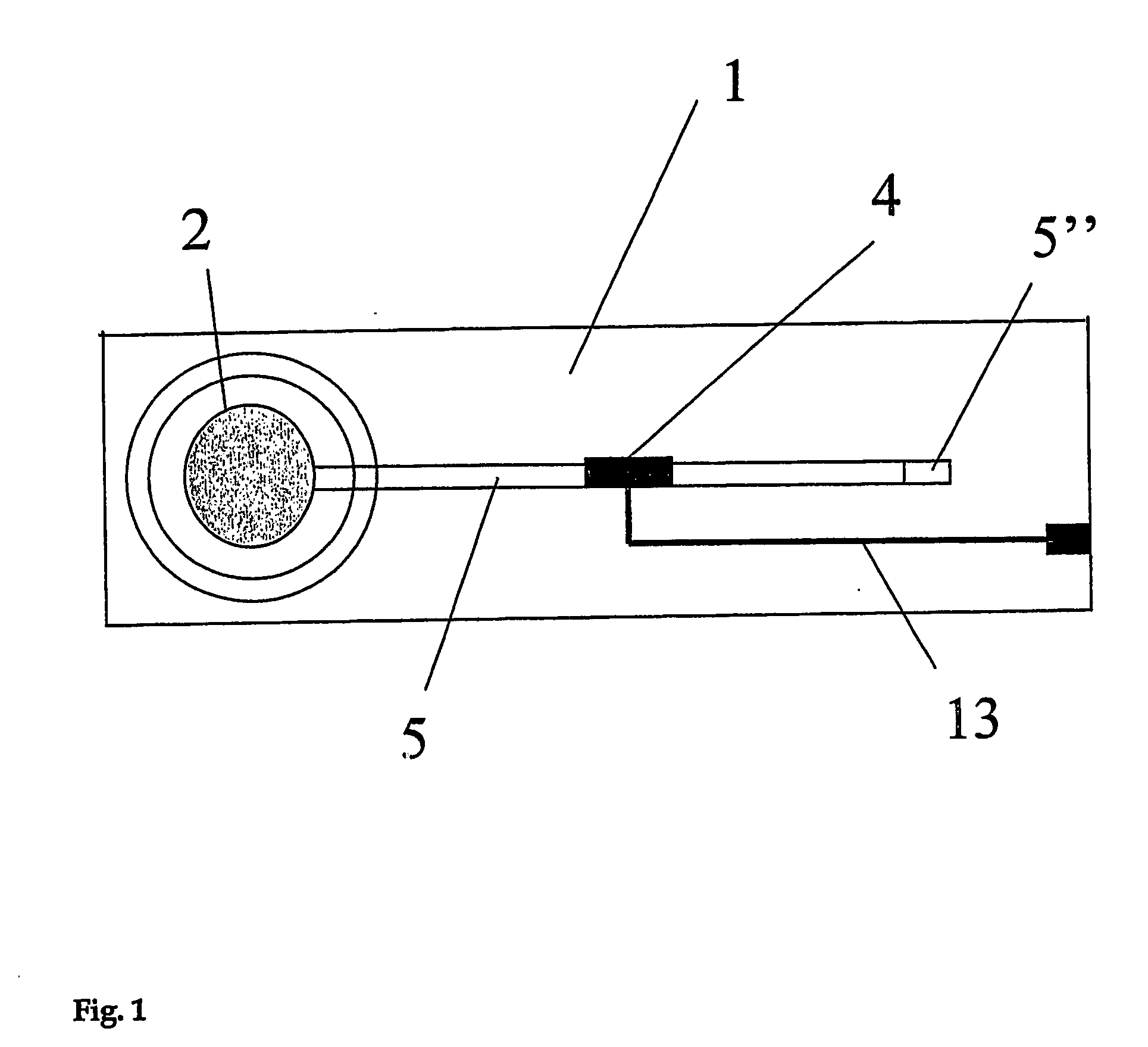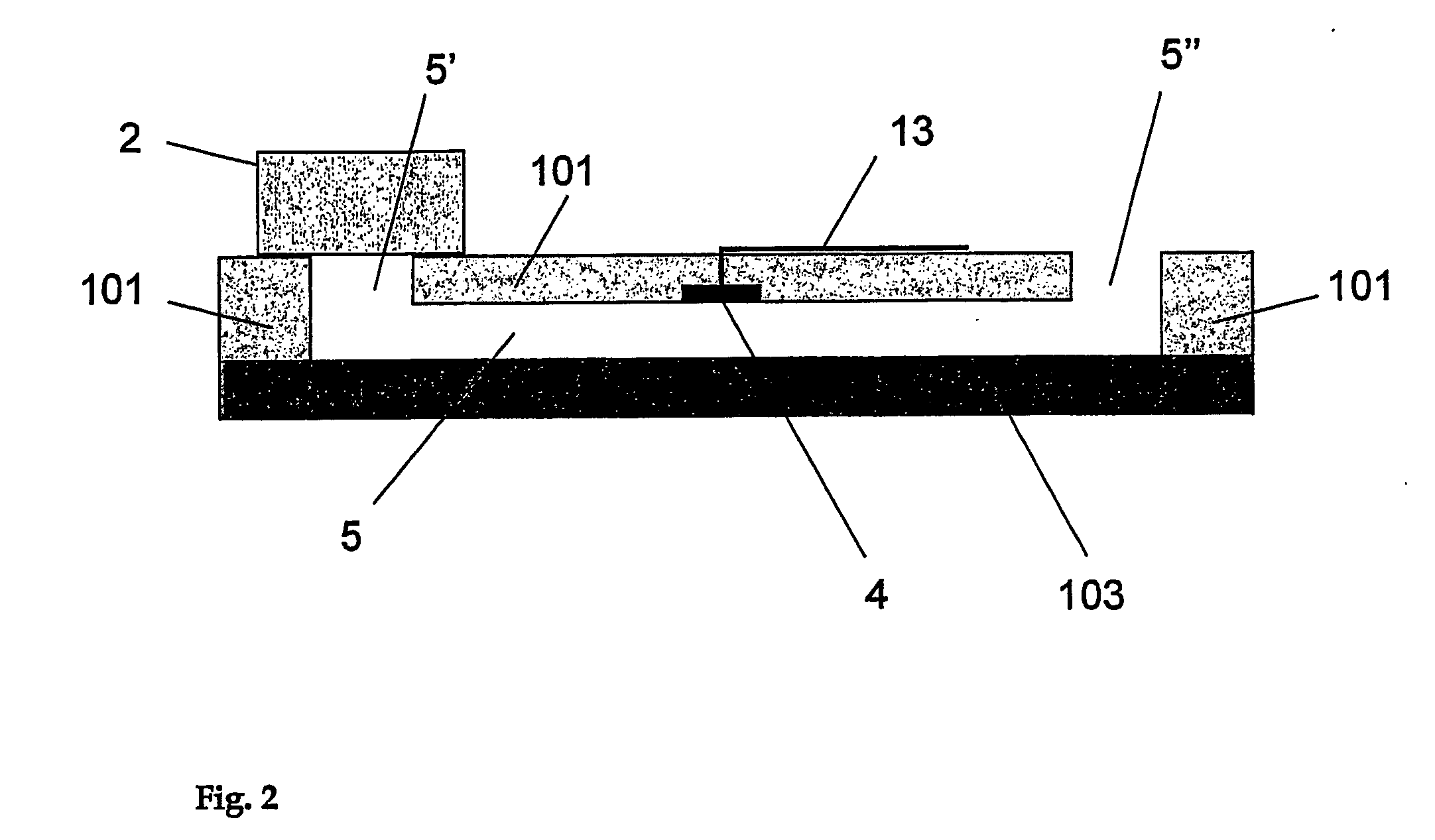Multi-layered electrochemical microfluidic sensor comprising reagent on porous layer
a microfluidic sensor and electrochemical technology, applied in biochemistry equipment, biochemistry equipment and processes, instruments, etc., can solve the problems of inability to quantitatively measure, color may slightly change, and difficult interpretation of band intensity and antigen concentration correlation
- Summary
- Abstract
- Description
- Claims
- Application Information
AI Technical Summary
Benefits of technology
Problems solved by technology
Method used
Image
Examples
example 1
[0072] In a first embodiment, the analyte to be tested in different test solutions is the proton concentration, namely the pH of the solution. In the apparatus shown in FIGS. 1 to 6, aminophenol (1 mM) is used as a reagent dried in the porous layer which is a cellulose membrane. This membrane is placed at the entrance of a microstructure serving as a fluidic connection. This microstructure is a 60 micrometer deep microchannel made of a 75 micrometer polyimide layer covered by a ˜40 micrometer thick polyethylene / polyethyleneterephthalate layer. The detection portion consists in an array of two microelectrodes that have an approximate diameter of 50 micrometers and that are made of copper coated by electroplated gold. These microelectrodes are part of the microchannel wall and exhibit a recess of about 15 micrometers. These microelectrodes are connected to an external potentiostat by way of gold / copper electrical tracks that are connected to a portable potentiostat (Pal...
example 2
Enzymatic Reaction (Case I: Substrate or Mediator in the Porous Layer)
[0076] In a further embodiment, the reagent placed in the porous layer is hydroquinone (HQ) which acts as a mediator in the enzymatic detection of the enzyme horseradish peroxidase (HRP) in the presence of H2O2 following the mechanism already described elsewhere Rossier et al. Lab-on-a-Chip, 2001,1,153-157).
[0077] The following conditions are shown in FIG. 23: [0078] A) cyclic voltammogram of the mixture of 10 mM hydroquinone and 10 mM H2O2 in phosphate buffer saline solution PBS pH 7.2; [0079] B) cyclic voltammogram of the mixture of 10 mM hydroquinone and 10 mM H2O2 in phosphate buffer saline solution PBS pH 7.2 with HRP added to the solution; [0080] C) cyclic voltammogram obtained with the apparatus shown in FIGS. 1 to 6 where hydroquinone is immobilized in the membrane as reagent and where H2O2 and horseradish peroxidase (HRP) are used as test solution in phosphate buffer saline solution PBS pH 7.2; [0081] D...
example 3
Enzymatic Reaction (Case II: Enzyme in the Porous Layer)
[0085] In another embodiment, the enzyme is immobilized in the membrane so as to be dissolved by the test solution, here HQ / H2O2. The reaction occurs and the solution with the enzyme is brought towards the detection portion as shown in FIG. 23 line E where HRP was first dried in the membrane. In order to favor the dissolution and displacement of the enzyme towards the detection portion, the membrane can be precoated with bovine serum albumin (BSA) in order to avoid significant non specific adsorption of the enzyme in the membrane.
PUM
| Property | Measurement | Unit |
|---|---|---|
| diameter | aaaaa | aaaaa |
| pH | aaaaa | aaaaa |
| microstructure | aaaaa | aaaaa |
Abstract
Description
Claims
Application Information
 Login to View More
Login to View More - R&D
- Intellectual Property
- Life Sciences
- Materials
- Tech Scout
- Unparalleled Data Quality
- Higher Quality Content
- 60% Fewer Hallucinations
Browse by: Latest US Patents, China's latest patents, Technical Efficacy Thesaurus, Application Domain, Technology Topic, Popular Technical Reports.
© 2025 PatSnap. All rights reserved.Legal|Privacy policy|Modern Slavery Act Transparency Statement|Sitemap|About US| Contact US: help@patsnap.com



